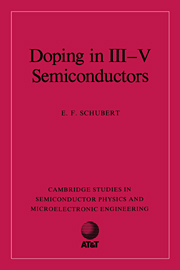Book contents
- Frontmatter
- Contents
- Foreword
- Preface
- List of symbols
- Introduction
- 1 Shallow impurities
- 2 Phenomenology of deep levels
- 3 Semiconductor statistics
- 4 Growth technologies
- 5 Doping with elemental sources
- 6 Gaseous doping sources
- 7 Impurity characteristics
- 8 Redistribution of impurities
- 9 Deep centers
- 10 Doping in heterostructures, quantum wells, and superlattices
- 11 Delta doping
- 12 Characterization techniques
- Appendix A Properties of III–V semiconductors
- Appendix B Constants and conversions
- References
- Index
1 - Shallow impurities
Published online by Cambridge University Press: 05 October 2010
- Frontmatter
- Contents
- Foreword
- Preface
- List of symbols
- Introduction
- 1 Shallow impurities
- 2 Phenomenology of deep levels
- 3 Semiconductor statistics
- 4 Growth technologies
- 5 Doping with elemental sources
- 6 Gaseous doping sources
- 7 Impurity characteristics
- 8 Redistribution of impurities
- 9 Deep centers
- 10 Doping in heterostructures, quantum wells, and superlattices
- 11 Delta doping
- 12 Characterization techniques
- Appendix A Properties of III–V semiconductors
- Appendix B Constants and conversions
- References
- Index
Summary
Shallow impurities are of great technological importance in semiconductors since they determine the conductivity and the carrier type of the semiconductor. Shallow impurities are defined as impurities which are ionized at room temperature. This condition limits the ionization energy of such impurities to values « 100 meV. Shallow impurities can be either acceptors or donors, i.e. ‘accept’ electrons from the valence band or ‘donate’ electrons to the conduction band.
The hydrogen atom model can serve as the basis for the calculation of many properties of shallow impurities such as ionization energy and state wave functions. In this chapter, the hydrogen atom is analyzed in terms of Bohr's semi-classical model and in terms of a quantum mechanical approach. The hydrogen atom model is then applied to shallow impurities. Properties such as ionization energies, wave functions, central cell correction terms, and screening of impurity potentials by free carriers are summarized. Effects associated with high impurity or high free carrier concentrations are also discussed including the Mott transition, the Burstein–Moss shift, band tails, impurity bands, and bandgap shrinkage.
Hydrogenic impurities
Impurities in semiconductors can be incorporated on substitutional sites, interstitial sites, or as impurity complexes. Here, we restrict ourselves to substitutional, shallow impurities. Examples for such impurities are Be, Zn, Si, and Sn. These impurities are shallow, i.e. their ionization energy is comparable to the thermal energy kT at room temperature.
- Type
- Chapter
- Information
- Doping in III-V Semiconductors , pp. 6 - 53Publisher: Cambridge University PressPrint publication year: 1993
- 1
- Cited by



